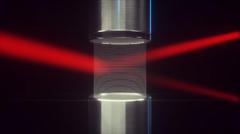URL: https://www.desy.de/news/news_search/index_eng.html
Breadcrumb Navigation
DESY News: Lasers deflected using air
News
News from the DESY research centre
Lasers deflected using air
Using a novel method, beams of laser light can be deflected using air alone. An invisible grating made only of air is not only immune to damage from the laser light, but it also preserves the original quality of the beam, reports the interdisciplinary research team in the journal Nature Photonics. The researchers have applied for a patent for their method.
The innovative technology was developed in a collaboration between DESY, the Technical University of Darmstadt (TUD), Aalen University, the University of Hamburg, the company Inoson GmbH in St. Ingbert and the Helmholtz Institute in Jena. It uses sound waves in order to modulate the air in the region where the laser beam is passing. “We’ve generated an optical grating with the help of acoustic density waves,” explains first author Yannick Schrödel, a Ph.D. student at DESY and Helmholtz Institute Jena. With the help of special loudspeakers, the researchers shape a pattern of dense and less dense areas in the air, forming a striped grating. In a way that is similar to how differential air densities bend the light in the Earth’s atmosphere, the density pattern takes on the role of an optical grating that changes the direction of the laser light beam. “However, deflecting light by diffraction grating allows much more precise control of the laser light compared to deflection in the Earth's atmosphere,” says Schrödel. “The properties of the optical grating are influenced by the frequency and intensity – in other words, the volume – of the sound waves.”
Thanks to the interdisciplinary collaboration, the acousto-optical modulation in air could already be demonstrated during an initial measurement campaign in the laser laboratory at DESY. "A major challenge was to achieve the high sound pressure level of 140 decibels at a frequency of 500 kilohertz in air," explains Claas Hartmann, research associate in the Department of Measurement and Sensor Technology at TUD. "A jet engine reaches such a high sound level at a distance of just a few metres." The acoustic transducer developed for this purpose in cooperation with the TUD and the company Inoson GmbH is capable of generating the required acoustic field. Further optimisation of the design makes it possible to deflect laser pulses with an efficiency of over 50 percent.
Here you can try out the deflection of the laser light by sound waves by sliding the slider:
The team sees great potential in the technique for high-performance optics. In their experiments, the researchers used an infrared laser pulse with a peak power of 20 gigawatts, which corresponds to the power of around two billion LED bulbs. Lasers of this and even higher power classes are used, for example, for material processing, in fusion research, or for the latest particle accelerators. “In this power range, the material properties of mirrors, lenses, and prisms significantly limit their use, and such optical elements are easily damaged by strong laser beams in practice,” explains Christoph Heyl, a scientist at DESY and the Helmholtz Institute Jena, who is leading the research project. “In addition, the quality of the laser beam suffers. In contrast, we’ve managed to deflect laser beams in a quality-preserving way without contact.”

The development team in the clean room working on the acoustic laser optics. Image: DESY, Angela Pfeiffer
The deflection of light directly into ambient air, which has already been demonstrated, opens up promising applications, especially as a fast switch for high-power lasers. “The potential of contactless control of light and its extension to other applications can currently only be imagined,” explains Heyl. “Modern optics is based almost exclusively on the interaction of light with solid matter. Our approach opens up a completely new direction.”
Researchers from the Technical University of Darmstadt, Aalen University of Applied Sciences, Universität Hamburg, Inoson GmbH in St. Ingbert, the Helmholtz Institute Jena, and DESY were involved in the work. The new technology is being developed as part of the research project SOPHIMA - Sono-Photonics in Metafluids. The research project is funded by the Carl Zeiss Foundation.
Reference:
Acousto-optic modulation of gigawatt-scale laser pulses in ambient air; Yannick Schrödel, Claas Hartmann, Tino Lang, Jiaan Zheng, Max Steudel, Matthias Rutsch, Sarper H. Salman, Martin Kellert, Mikhail Pergament, Thomas Hahn-Jose, Sven Suppelt, Jan Helge Dörsam, Anne Harth, Wim P. Leemans, Franz X. Kärtner, Ingmar Hartl, Mario Kupnik, Christoph M. Heyl; Nature Photonics, 2023; DOI: 10.1038/s41566-023-01304-y




